Functional Areas Report: Business Functions and Employee Skills
VerifiedAdded on 2022/12/14
|7
|1908
|246
Report
AI Summary
This report examines the functional areas within a business, including operations, marketing, human resources, accounting, and finance. It analyzes the skills essential for employees to work effectively in these areas, such as communication, technological proficiency, teamwork, commitment, flexibility, and leadership potential. The report is based on a case study where a lottery winner, John, purchases IOM Electronics LTD and needs advice on running the company. The report provides insights into how each functional area contributes to the overall success of a business, emphasizing the importance of employee skills in achieving organizational goals. It highlights the need for coordination and cooperation among departments to ensure proper business functioning and the attainment of set targets.
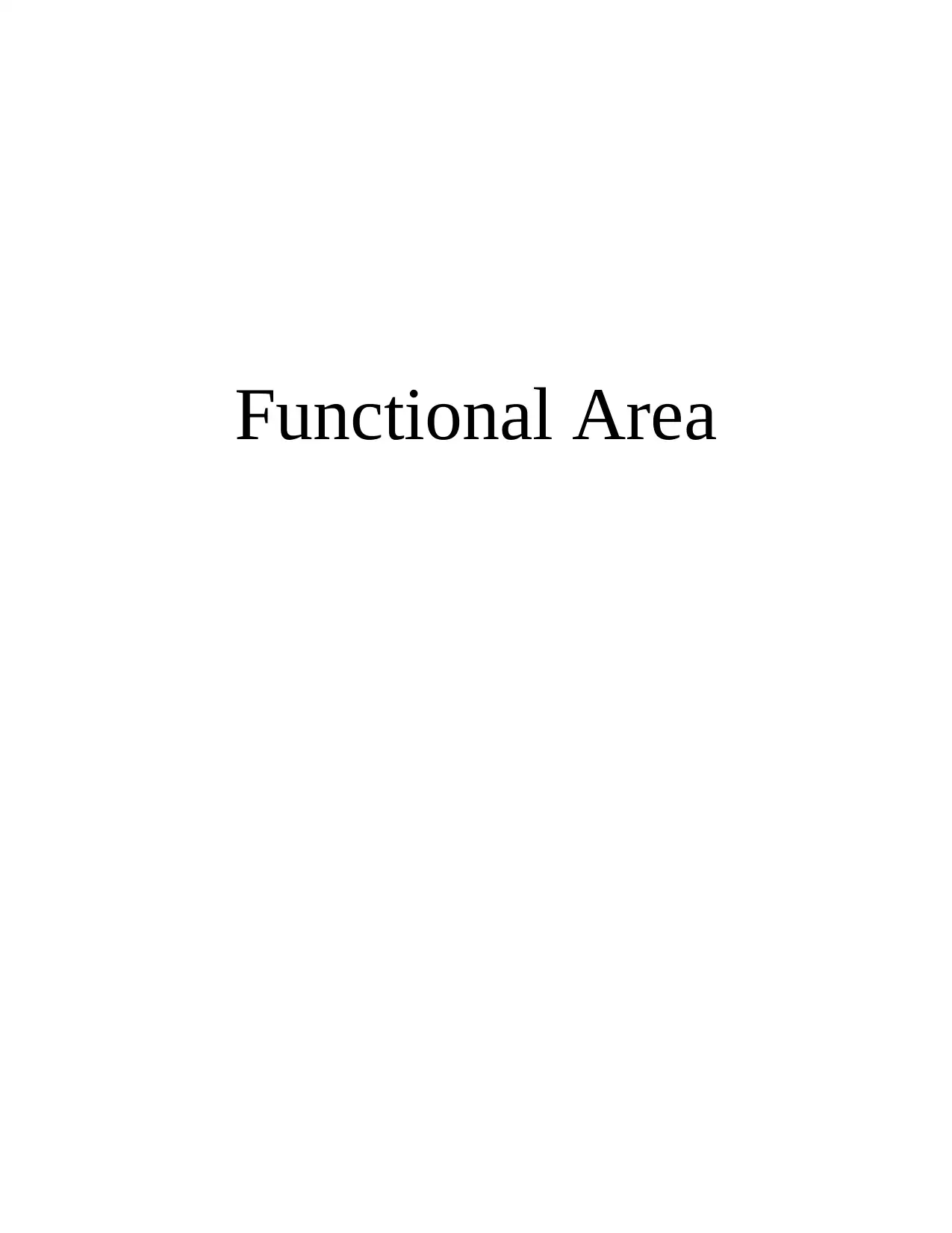
Functional Area
Paraphrase This Document
Need a fresh take? Get an instant paraphrase of this document with our AI Paraphraser
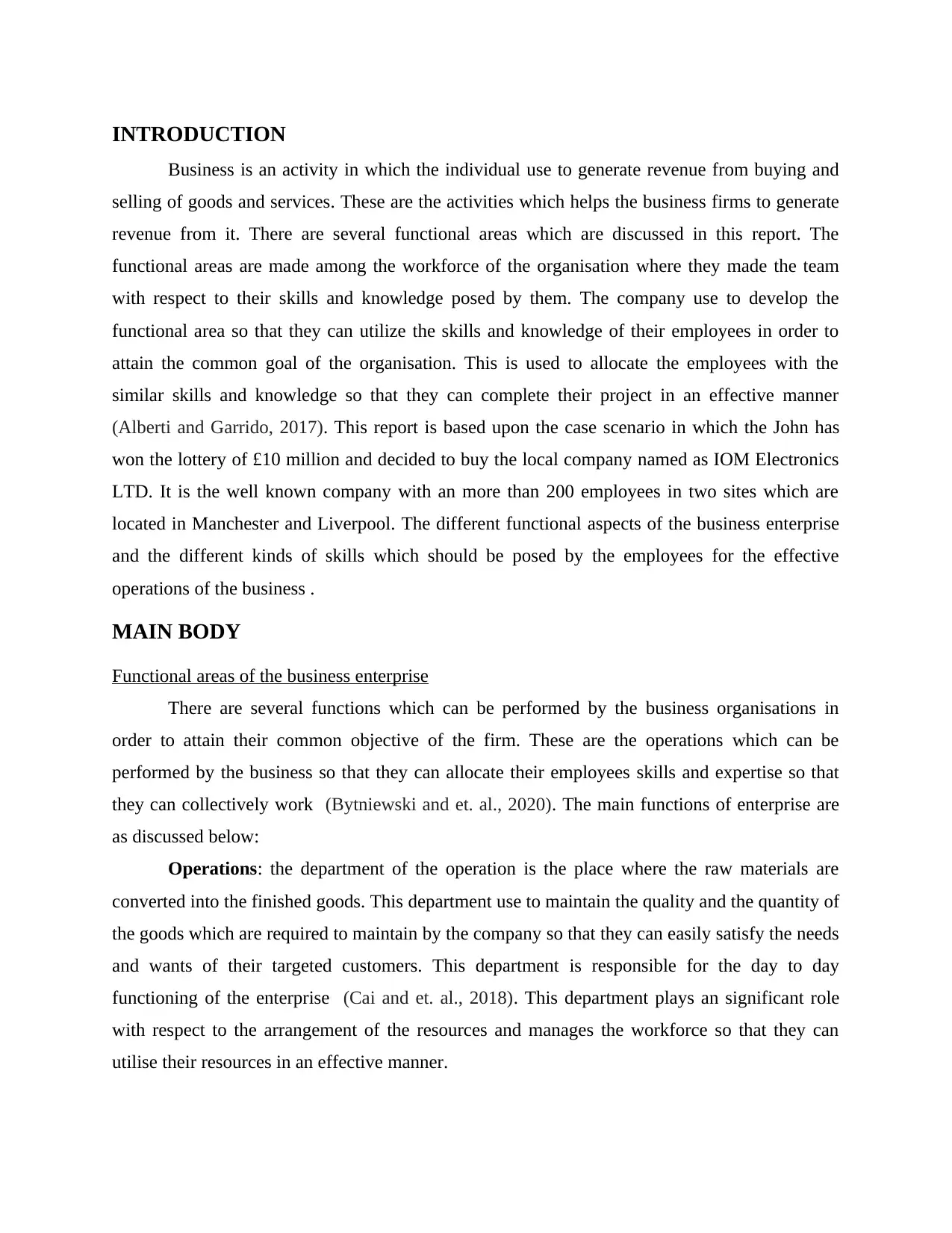
INTRODUCTION
Business is an activity in which the individual use to generate revenue from buying and
selling of goods and services. These are the activities which helps the business firms to generate
revenue from it. There are several functional areas which are discussed in this report. The
functional areas are made among the workforce of the organisation where they made the team
with respect to their skills and knowledge posed by them. The company use to develop the
functional area so that they can utilize the skills and knowledge of their employees in order to
attain the common goal of the organisation. This is used to allocate the employees with the
similar skills and knowledge so that they can complete their project in an effective manner
(Alberti and Garrido, 2017). This report is based upon the case scenario in which the John has
won the lottery of £10 million and decided to buy the local company named as IOM Electronics
LTD. It is the well known company with an more than 200 employees in two sites which are
located in Manchester and Liverpool. The different functional aspects of the business enterprise
and the different kinds of skills which should be posed by the employees for the effective
operations of the business .
MAIN BODY
Functional areas of the business enterprise
There are several functions which can be performed by the business organisations in
order to attain their common objective of the firm. These are the operations which can be
performed by the business so that they can allocate their employees skills and expertise so that
they can collectively work (Bytniewski and et. al., 2020). The main functions of enterprise are
as discussed below:
Operations: the department of the operation is the place where the raw materials are
converted into the finished goods. This department use to maintain the quality and the quantity of
the goods which are required to maintain by the company so that they can easily satisfy the needs
and wants of their targeted customers. This department is responsible for the day to day
functioning of the enterprise (Cai and et. al., 2018). This department plays an significant role
with respect to the arrangement of the resources and manages the workforce so that they can
utilise their resources in an effective manner.
Business is an activity in which the individual use to generate revenue from buying and
selling of goods and services. These are the activities which helps the business firms to generate
revenue from it. There are several functional areas which are discussed in this report. The
functional areas are made among the workforce of the organisation where they made the team
with respect to their skills and knowledge posed by them. The company use to develop the
functional area so that they can utilize the skills and knowledge of their employees in order to
attain the common goal of the organisation. This is used to allocate the employees with the
similar skills and knowledge so that they can complete their project in an effective manner
(Alberti and Garrido, 2017). This report is based upon the case scenario in which the John has
won the lottery of £10 million and decided to buy the local company named as IOM Electronics
LTD. It is the well known company with an more than 200 employees in two sites which are
located in Manchester and Liverpool. The different functional aspects of the business enterprise
and the different kinds of skills which should be posed by the employees for the effective
operations of the business .
MAIN BODY
Functional areas of the business enterprise
There are several functions which can be performed by the business organisations in
order to attain their common objective of the firm. These are the operations which can be
performed by the business so that they can allocate their employees skills and expertise so that
they can collectively work (Bytniewski and et. al., 2020). The main functions of enterprise are
as discussed below:
Operations: the department of the operation is the place where the raw materials are
converted into the finished goods. This department use to maintain the quality and the quantity of
the goods which are required to maintain by the company so that they can easily satisfy the needs
and wants of their targeted customers. This department is responsible for the day to day
functioning of the enterprise (Cai and et. al., 2018). This department plays an significant role
with respect to the arrangement of the resources and manages the workforce so that they can
utilise their resources in an effective manner.
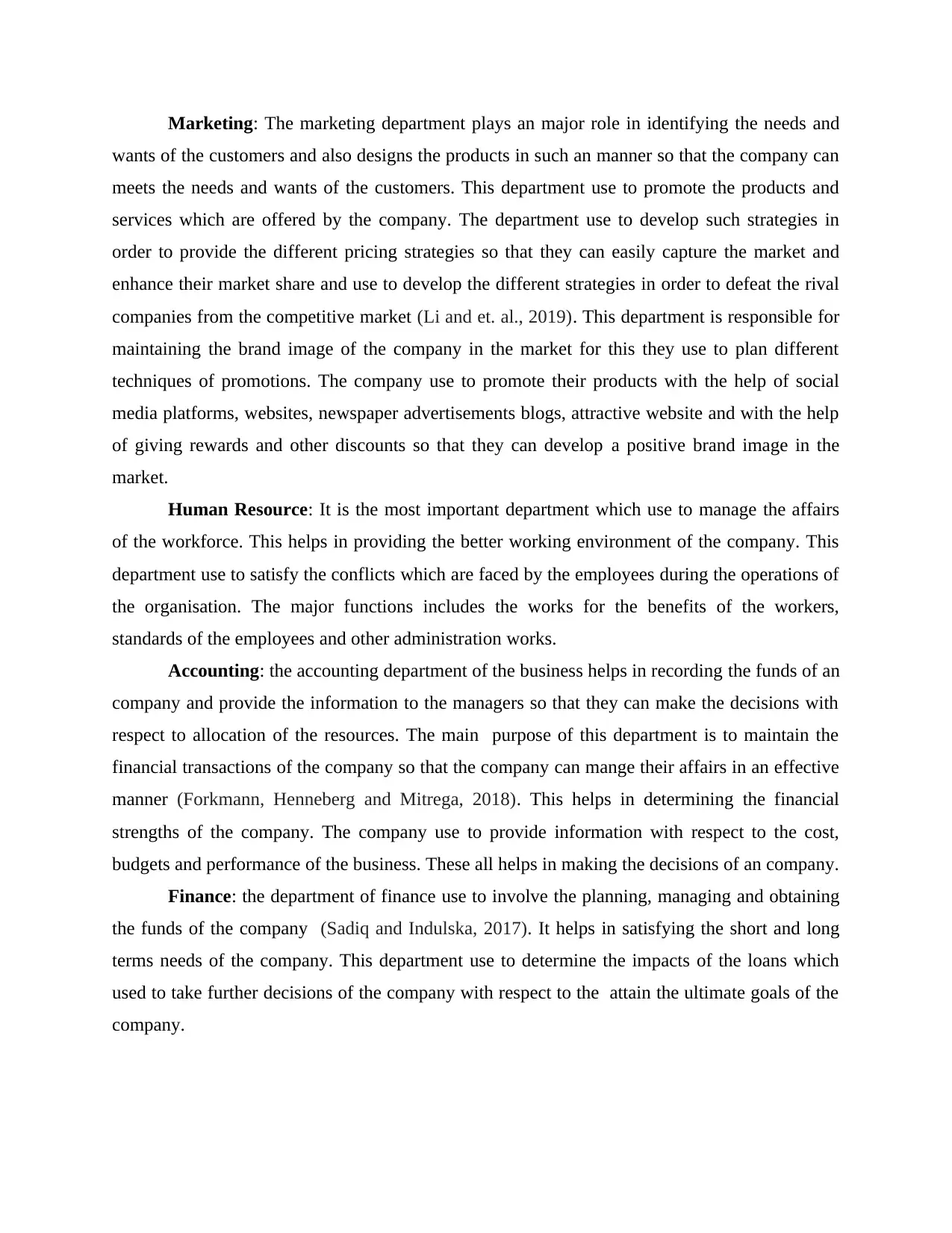
Marketing: The marketing department plays an major role in identifying the needs and
wants of the customers and also designs the products in such an manner so that the company can
meets the needs and wants of the customers. This department use to promote the products and
services which are offered by the company. The department use to develop such strategies in
order to provide the different pricing strategies so that they can easily capture the market and
enhance their market share and use to develop the different strategies in order to defeat the rival
companies from the competitive market (Li and et. al., 2019). This department is responsible for
maintaining the brand image of the company in the market for this they use to plan different
techniques of promotions. The company use to promote their products with the help of social
media platforms, websites, newspaper advertisements blogs, attractive website and with the help
of giving rewards and other discounts so that they can develop a positive brand image in the
market.
Human Resource: It is the most important department which use to manage the affairs
of the workforce. This helps in providing the better working environment of the company. This
department use to satisfy the conflicts which are faced by the employees during the operations of
the organisation. The major functions includes the works for the benefits of the workers,
standards of the employees and other administration works.
Accounting: the accounting department of the business helps in recording the funds of an
company and provide the information to the managers so that they can make the decisions with
respect to allocation of the resources. The main purpose of this department is to maintain the
financial transactions of the company so that the company can mange their affairs in an effective
manner (Forkmann, Henneberg and Mitrega, 2018). This helps in determining the financial
strengths of the company. The company use to provide information with respect to the cost,
budgets and performance of the business. These all helps in making the decisions of an company.
Finance: the department of finance use to involve the planning, managing and obtaining
the funds of the company (Sadiq and Indulska, 2017). It helps in satisfying the short and long
terms needs of the company. This department use to determine the impacts of the loans which
used to take further decisions of the company with respect to the attain the ultimate goals of the
company.
wants of the customers and also designs the products in such an manner so that the company can
meets the needs and wants of the customers. This department use to promote the products and
services which are offered by the company. The department use to develop such strategies in
order to provide the different pricing strategies so that they can easily capture the market and
enhance their market share and use to develop the different strategies in order to defeat the rival
companies from the competitive market (Li and et. al., 2019). This department is responsible for
maintaining the brand image of the company in the market for this they use to plan different
techniques of promotions. The company use to promote their products with the help of social
media platforms, websites, newspaper advertisements blogs, attractive website and with the help
of giving rewards and other discounts so that they can develop a positive brand image in the
market.
Human Resource: It is the most important department which use to manage the affairs
of the workforce. This helps in providing the better working environment of the company. This
department use to satisfy the conflicts which are faced by the employees during the operations of
the organisation. The major functions includes the works for the benefits of the workers,
standards of the employees and other administration works.
Accounting: the accounting department of the business helps in recording the funds of an
company and provide the information to the managers so that they can make the decisions with
respect to allocation of the resources. The main purpose of this department is to maintain the
financial transactions of the company so that the company can mange their affairs in an effective
manner (Forkmann, Henneberg and Mitrega, 2018). This helps in determining the financial
strengths of the company. The company use to provide information with respect to the cost,
budgets and performance of the business. These all helps in making the decisions of an company.
Finance: the department of finance use to involve the planning, managing and obtaining
the funds of the company (Sadiq and Indulska, 2017). It helps in satisfying the short and long
terms needs of the company. This department use to determine the impacts of the loans which
used to take further decisions of the company with respect to the attain the ultimate goals of the
company.
⊘ This is a preview!⊘
Do you want full access?
Subscribe today to unlock all pages.

Trusted by 1+ million students worldwide
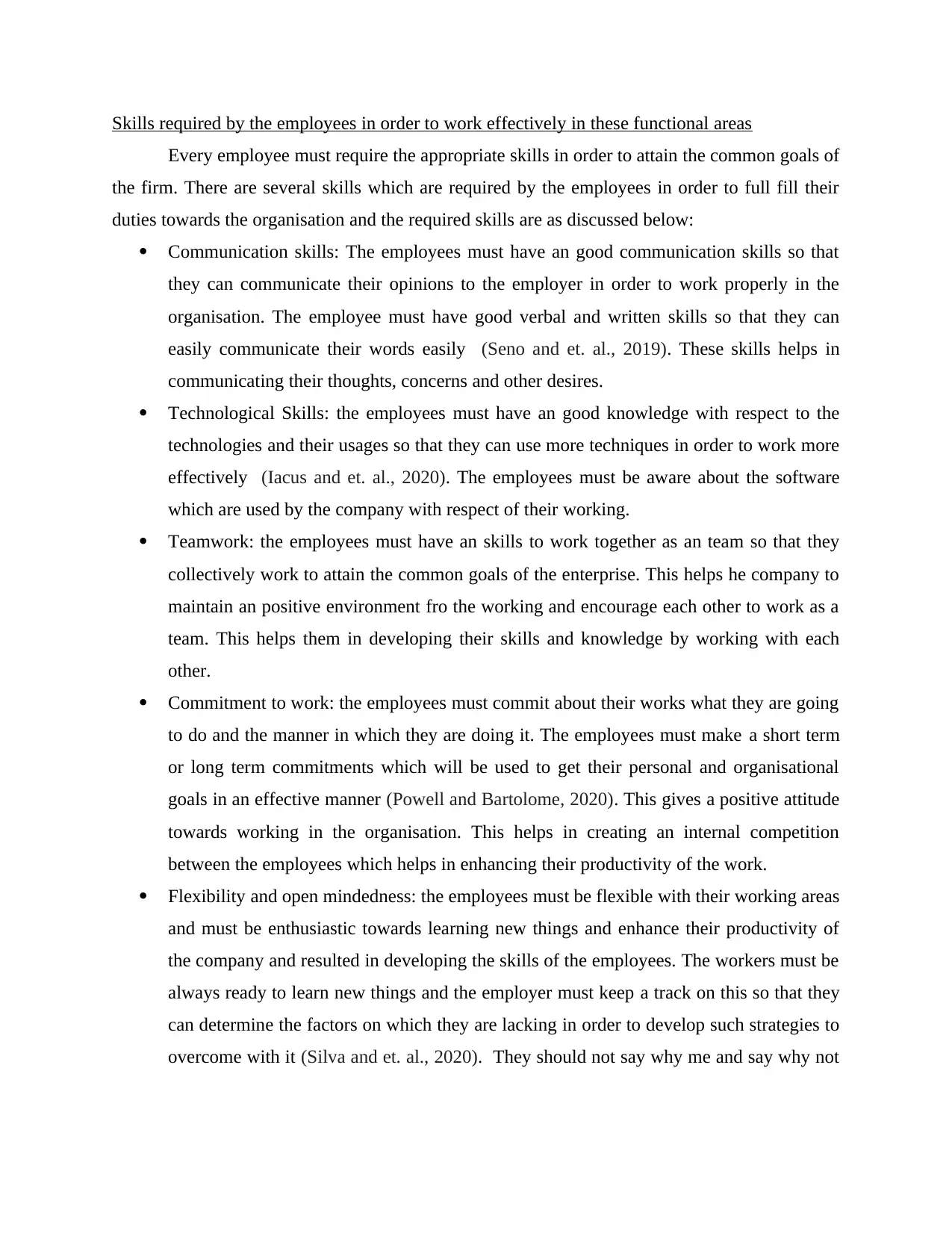
Skills required by the employees in order to work effectively in these functional areas
Every employee must require the appropriate skills in order to attain the common goals of
the firm. There are several skills which are required by the employees in order to full fill their
duties towards the organisation and the required skills are as discussed below:
Communication skills: The employees must have an good communication skills so that
they can communicate their opinions to the employer in order to work properly in the
organisation. The employee must have good verbal and written skills so that they can
easily communicate their words easily (Seno and et. al., 2019). These skills helps in
communicating their thoughts, concerns and other desires.
Technological Skills: the employees must have an good knowledge with respect to the
technologies and their usages so that they can use more techniques in order to work more
effectively (Iacus and et. al., 2020). The employees must be aware about the software
which are used by the company with respect of their working.
Teamwork: the employees must have an skills to work together as an team so that they
collectively work to attain the common goals of the enterprise. This helps he company to
maintain an positive environment fro the working and encourage each other to work as a
team. This helps them in developing their skills and knowledge by working with each
other.
Commitment to work: the employees must commit about their works what they are going
to do and the manner in which they are doing it. The employees must make a short term
or long term commitments which will be used to get their personal and organisational
goals in an effective manner (Powell and Bartolome, 2020). This gives a positive attitude
towards working in the organisation. This helps in creating an internal competition
between the employees which helps in enhancing their productivity of the work.
Flexibility and open mindedness: the employees must be flexible with their working areas
and must be enthusiastic towards learning new things and enhance their productivity of
the company and resulted in developing the skills of the employees. The workers must be
always ready to learn new things and the employer must keep a track on this so that they
can determine the factors on which they are lacking in order to develop such strategies to
overcome with it (Silva and et. al., 2020). They should not say why me and say why not
Every employee must require the appropriate skills in order to attain the common goals of
the firm. There are several skills which are required by the employees in order to full fill their
duties towards the organisation and the required skills are as discussed below:
Communication skills: The employees must have an good communication skills so that
they can communicate their opinions to the employer in order to work properly in the
organisation. The employee must have good verbal and written skills so that they can
easily communicate their words easily (Seno and et. al., 2019). These skills helps in
communicating their thoughts, concerns and other desires.
Technological Skills: the employees must have an good knowledge with respect to the
technologies and their usages so that they can use more techniques in order to work more
effectively (Iacus and et. al., 2020). The employees must be aware about the software
which are used by the company with respect of their working.
Teamwork: the employees must have an skills to work together as an team so that they
collectively work to attain the common goals of the enterprise. This helps he company to
maintain an positive environment fro the working and encourage each other to work as a
team. This helps them in developing their skills and knowledge by working with each
other.
Commitment to work: the employees must commit about their works what they are going
to do and the manner in which they are doing it. The employees must make a short term
or long term commitments which will be used to get their personal and organisational
goals in an effective manner (Powell and Bartolome, 2020). This gives a positive attitude
towards working in the organisation. This helps in creating an internal competition
between the employees which helps in enhancing their productivity of the work.
Flexibility and open mindedness: the employees must be flexible with their working areas
and must be enthusiastic towards learning new things and enhance their productivity of
the company and resulted in developing the skills of the employees. The workers must be
always ready to learn new things and the employer must keep a track on this so that they
can determine the factors on which they are lacking in order to develop such strategies to
overcome with it (Silva and et. al., 2020). They should not say why me and say why not
Paraphrase This Document
Need a fresh take? Get an instant paraphrase of this document with our AI Paraphraser
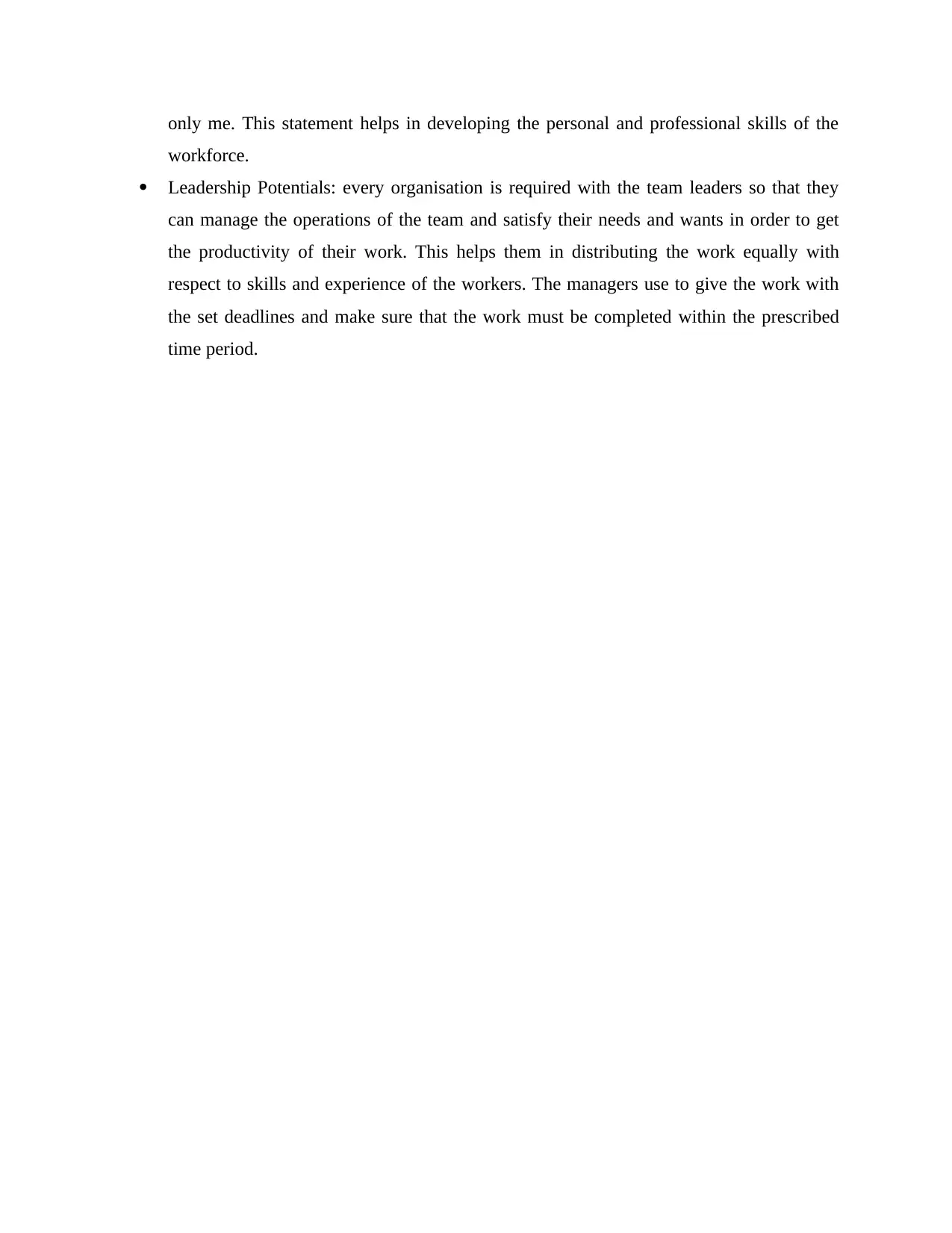
only me. This statement helps in developing the personal and professional skills of the
workforce.
Leadership Potentials: every organisation is required with the team leaders so that they
can manage the operations of the team and satisfy their needs and wants in order to get
the productivity of their work. This helps them in distributing the work equally with
respect to skills and experience of the workers. The managers use to give the work with
the set deadlines and make sure that the work must be completed within the prescribed
time period.
workforce.
Leadership Potentials: every organisation is required with the team leaders so that they
can manage the operations of the team and satisfy their needs and wants in order to get
the productivity of their work. This helps them in distributing the work equally with
respect to skills and experience of the workers. The managers use to give the work with
the set deadlines and make sure that the work must be completed within the prescribed
time period.
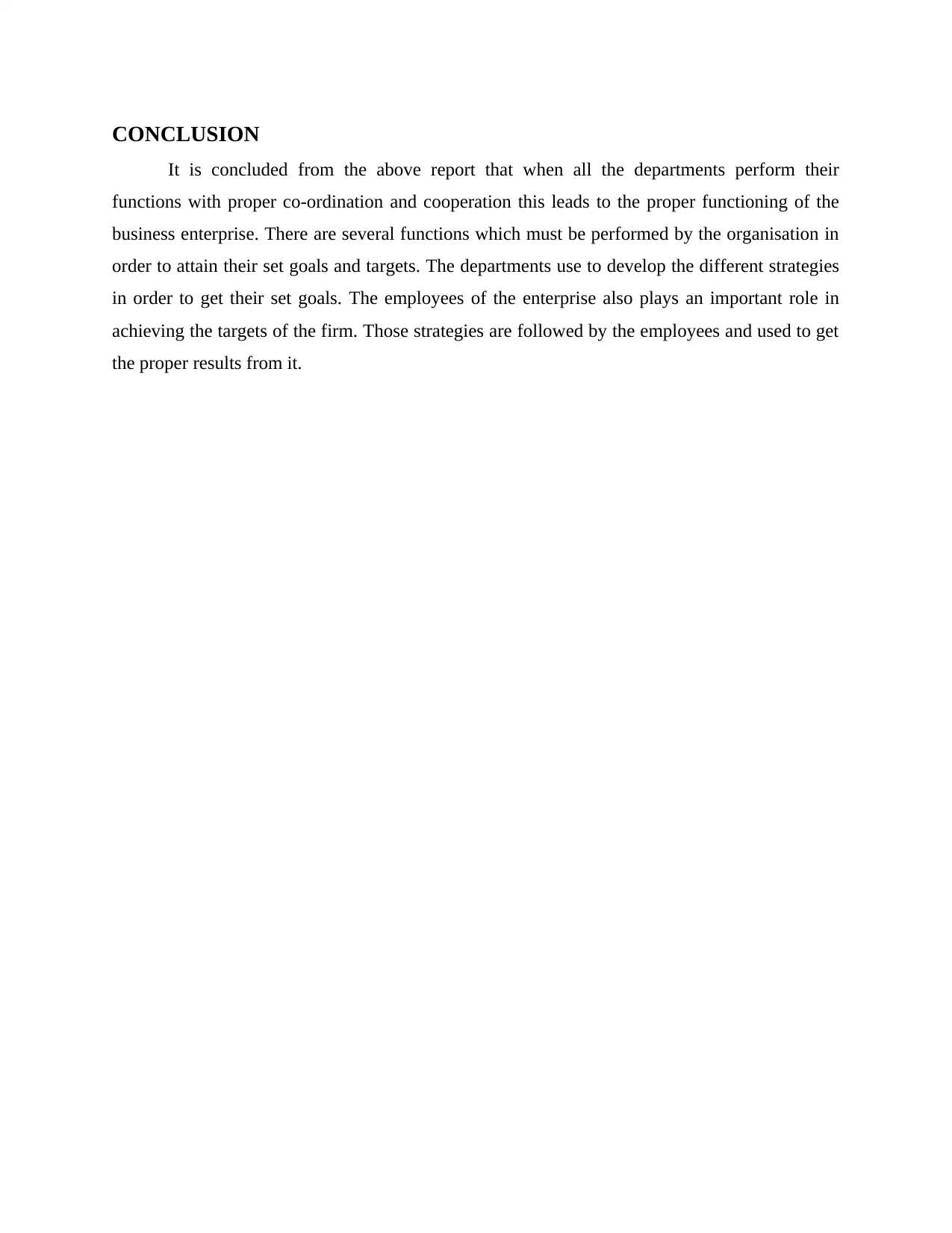
CONCLUSION
It is concluded from the above report that when all the departments perform their
functions with proper co-ordination and cooperation this leads to the proper functioning of the
business enterprise. There are several functions which must be performed by the organisation in
order to attain their set goals and targets. The departments use to develop the different strategies
in order to get their set goals. The employees of the enterprise also plays an important role in
achieving the targets of the firm. Those strategies are followed by the employees and used to get
the proper results from it.
It is concluded from the above report that when all the departments perform their
functions with proper co-ordination and cooperation this leads to the proper functioning of the
business enterprise. There are several functions which must be performed by the organisation in
order to attain their set goals and targets. The departments use to develop the different strategies
in order to get their set goals. The employees of the enterprise also plays an important role in
achieving the targets of the firm. Those strategies are followed by the employees and used to get
the proper results from it.
⊘ This is a preview!⊘
Do you want full access?
Subscribe today to unlock all pages.

Trusted by 1+ million students worldwide
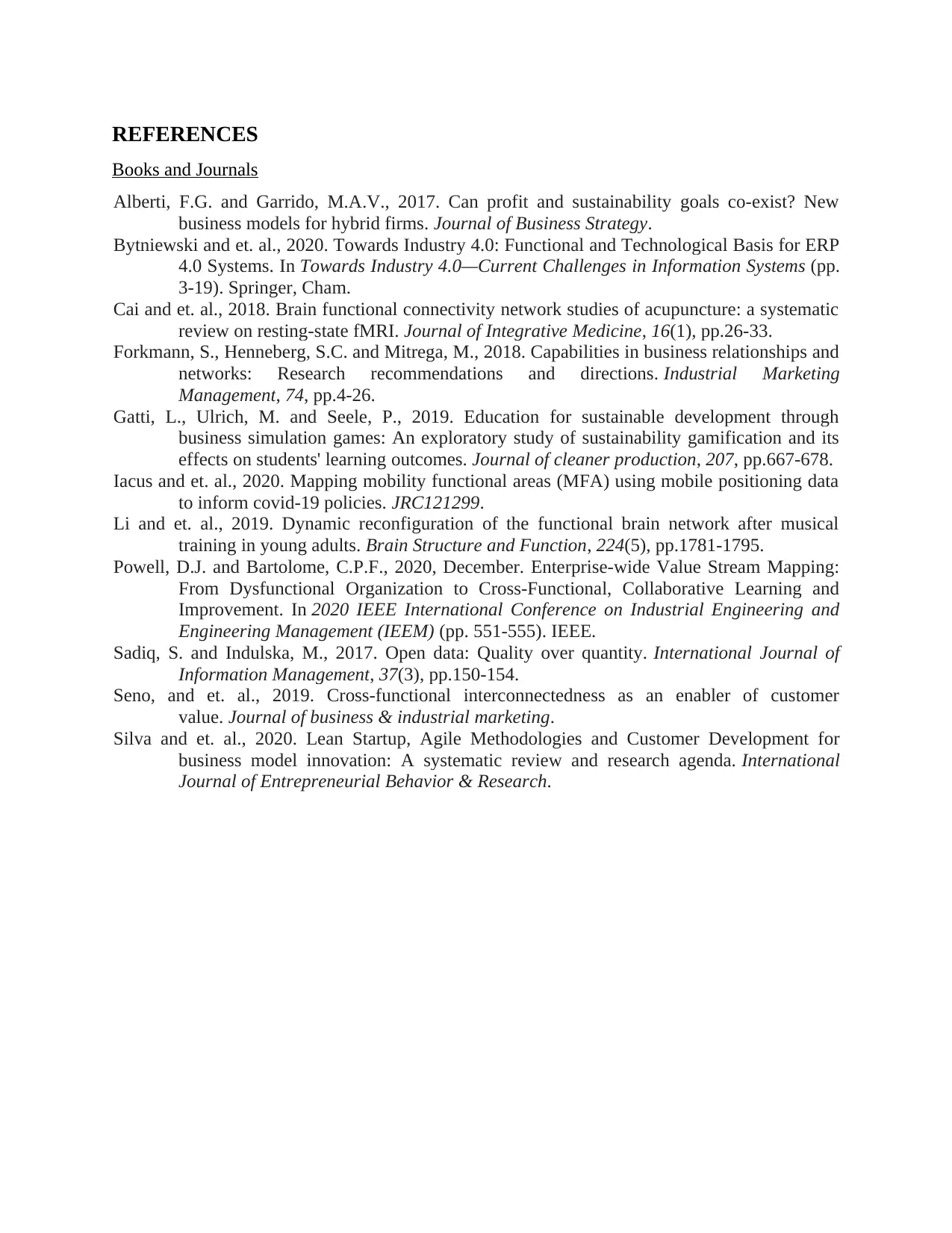
REFERENCES
Books and Journals
Alberti, F.G. and Garrido, M.A.V., 2017. Can profit and sustainability goals co-exist? New
business models for hybrid firms. Journal of Business Strategy.
Bytniewski and et. al., 2020. Towards Industry 4.0: Functional and Technological Basis for ERP
4.0 Systems. In Towards Industry 4.0—Current Challenges in Information Systems (pp.
3-19). Springer, Cham.
Cai and et. al., 2018. Brain functional connectivity network studies of acupuncture: a systematic
review on resting-state fMRI. Journal of Integrative Medicine, 16(1), pp.26-33.
Forkmann, S., Henneberg, S.C. and Mitrega, M., 2018. Capabilities in business relationships and
networks: Research recommendations and directions. Industrial Marketing
Management, 74, pp.4-26.
Gatti, L., Ulrich, M. and Seele, P., 2019. Education for sustainable development through
business simulation games: An exploratory study of sustainability gamification and its
effects on students' learning outcomes. Journal of cleaner production, 207, pp.667-678.
Iacus and et. al., 2020. Mapping mobility functional areas (MFA) using mobile positioning data
to inform covid-19 policies. JRC121299.
Li and et. al., 2019. Dynamic reconfiguration of the functional brain network after musical
training in young adults. Brain Structure and Function, 224(5), pp.1781-1795.
Powell, D.J. and Bartolome, C.P.F., 2020, December. Enterprise-wide Value Stream Mapping:
From Dysfunctional Organization to Cross-Functional, Collaborative Learning and
Improvement. In 2020 IEEE International Conference on Industrial Engineering and
Engineering Management (IEEM) (pp. 551-555). IEEE.
Sadiq, S. and Indulska, M., 2017. Open data: Quality over quantity. International Journal of
Information Management, 37(3), pp.150-154.
Seno, and et. al., 2019. Cross-functional interconnectedness as an enabler of customer
value. Journal of business & industrial marketing.
Silva and et. al., 2020. Lean Startup, Agile Methodologies and Customer Development for
business model innovation: A systematic review and research agenda. International
Journal of Entrepreneurial Behavior & Research.
Books and Journals
Alberti, F.G. and Garrido, M.A.V., 2017. Can profit and sustainability goals co-exist? New
business models for hybrid firms. Journal of Business Strategy.
Bytniewski and et. al., 2020. Towards Industry 4.0: Functional and Technological Basis for ERP
4.0 Systems. In Towards Industry 4.0—Current Challenges in Information Systems (pp.
3-19). Springer, Cham.
Cai and et. al., 2018. Brain functional connectivity network studies of acupuncture: a systematic
review on resting-state fMRI. Journal of Integrative Medicine, 16(1), pp.26-33.
Forkmann, S., Henneberg, S.C. and Mitrega, M., 2018. Capabilities in business relationships and
networks: Research recommendations and directions. Industrial Marketing
Management, 74, pp.4-26.
Gatti, L., Ulrich, M. and Seele, P., 2019. Education for sustainable development through
business simulation games: An exploratory study of sustainability gamification and its
effects on students' learning outcomes. Journal of cleaner production, 207, pp.667-678.
Iacus and et. al., 2020. Mapping mobility functional areas (MFA) using mobile positioning data
to inform covid-19 policies. JRC121299.
Li and et. al., 2019. Dynamic reconfiguration of the functional brain network after musical
training in young adults. Brain Structure and Function, 224(5), pp.1781-1795.
Powell, D.J. and Bartolome, C.P.F., 2020, December. Enterprise-wide Value Stream Mapping:
From Dysfunctional Organization to Cross-Functional, Collaborative Learning and
Improvement. In 2020 IEEE International Conference on Industrial Engineering and
Engineering Management (IEEM) (pp. 551-555). IEEE.
Sadiq, S. and Indulska, M., 2017. Open data: Quality over quantity. International Journal of
Information Management, 37(3), pp.150-154.
Seno, and et. al., 2019. Cross-functional interconnectedness as an enabler of customer
value. Journal of business & industrial marketing.
Silva and et. al., 2020. Lean Startup, Agile Methodologies and Customer Development for
business model innovation: A systematic review and research agenda. International
Journal of Entrepreneurial Behavior & Research.
1 out of 7
Related Documents
Your All-in-One AI-Powered Toolkit for Academic Success.
+13062052269
info@desklib.com
Available 24*7 on WhatsApp / Email
![[object Object]](/_next/static/media/star-bottom.7253800d.svg)
Unlock your academic potential
Copyright © 2020–2025 A2Z Services. All Rights Reserved. Developed and managed by ZUCOL.




